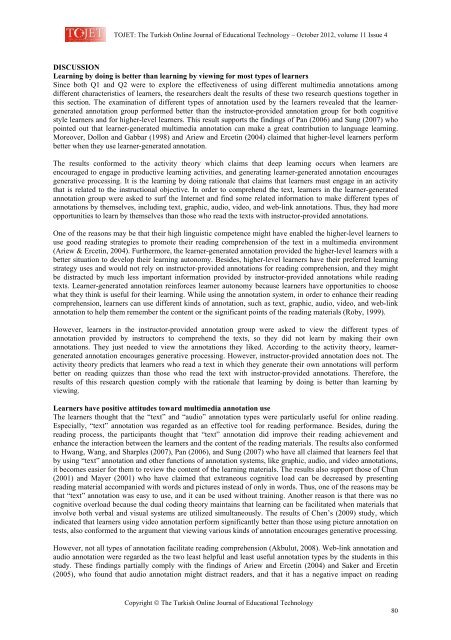october 2012 - TOJET the Turkish online journal of educational ...
october 2012 - TOJET the Turkish online journal of educational ...
october 2012 - TOJET the Turkish online journal of educational ...
You also want an ePaper? Increase the reach of your titles
YUMPU automatically turns print PDFs into web optimized ePapers that Google loves.
<strong>TOJET</strong>: The <strong>Turkish</strong> Online Journal <strong>of</strong> Educational Technology – October <strong>2012</strong>, volume 11 Issue 4<br />
DISCUSSION<br />
Learning by doing is better than learning by viewing for most types <strong>of</strong> learners<br />
Since both Q1 and Q2 were to explore <strong>the</strong> effectiveness <strong>of</strong> using different multimedia annotations among<br />
different characteristics <strong>of</strong> learners, <strong>the</strong> researchers dealt <strong>the</strong> results <strong>of</strong> <strong>the</strong>se two research questions toge<strong>the</strong>r in<br />
this section. The examination <strong>of</strong> different types <strong>of</strong> annotation used by <strong>the</strong> learners revealed that <strong>the</strong> learnergenerated<br />
annotation group performed better than <strong>the</strong> instructor-provided annotation group for both cognitive<br />
style learners and for higher-level learners. This result supports <strong>the</strong> findings <strong>of</strong> Pan (2006) and Sung (2007) who<br />
pointed out that learner-generated multimedia annotation can make a great contribution to language learning.<br />
Moreover, Dollon and Gabbar (1998) and Ariew and Ercetin (2004) claimed that higher-level learners perform<br />
better when <strong>the</strong>y use learner-generated annotation.<br />
The results conformed to <strong>the</strong> activity <strong>the</strong>ory which claims that deep learning occurs when learners are<br />
encouraged to engage in productive learning activities, and generating learner-generated annotation encourages<br />
generative processing. It is <strong>the</strong> learning by doing rationale that claims that learners must engage in an activity<br />
that is related to <strong>the</strong> instructional objective. In order to comprehend <strong>the</strong> text, learners in <strong>the</strong> learner-generated<br />
annotation group were asked to surf <strong>the</strong> Internet and find some related information to make different types <strong>of</strong><br />
annotations by <strong>the</strong>mselves, including text, graphic, audio, video, and web-link annotations. Thus, <strong>the</strong>y had more<br />
opportunities to learn by <strong>the</strong>mselves than those who read <strong>the</strong> texts with instructor-provided annotations.<br />
One <strong>of</strong> <strong>the</strong> reasons may be that <strong>the</strong>ir high linguistic competence might have enabled <strong>the</strong> higher-level learners to<br />
use good reading strategies to promote <strong>the</strong>ir reading comprehension <strong>of</strong> <strong>the</strong> text in a multimedia environment<br />
(Ariew & Ercetin, 2004). Fur<strong>the</strong>rmore, <strong>the</strong> learner-generated annotation provided <strong>the</strong> higher-level learners with a<br />
better situation to develop <strong>the</strong>ir learning autonomy. Besides, higher-level learners have <strong>the</strong>ir preferred learning<br />
strategy uses and would not rely on instructor-provided annotations for reading comprehension, and <strong>the</strong>y might<br />
be distracted by much less important information provided by instructor-provided annotations while reading<br />
texts. Learner-generated annotation reinforces learner autonomy because learners have opportunities to choose<br />
what <strong>the</strong>y think is useful for <strong>the</strong>ir learning. While using <strong>the</strong> annotation system, in order to enhance <strong>the</strong>ir reading<br />
comprehension, learners can use different kinds <strong>of</strong> annotation, such as text, graphic, audio, video, and web-link<br />
annotation to help <strong>the</strong>m remember <strong>the</strong> content or <strong>the</strong> significant points <strong>of</strong> <strong>the</strong> reading materials (Roby, 1999).<br />
However, learners in <strong>the</strong> instructor-provided annotation group were asked to view <strong>the</strong> different types <strong>of</strong><br />
annotation provided by instructors to comprehend <strong>the</strong> texts, so <strong>the</strong>y did not learn by making <strong>the</strong>ir own<br />
annotations. They just needed to view <strong>the</strong> annotations <strong>the</strong>y liked. According to <strong>the</strong> activity <strong>the</strong>ory, learnergenerated<br />
annotation encourages generative processing. However, instructor-provided annotation does not. The<br />
activity <strong>the</strong>ory predicts that learners who read a text in which <strong>the</strong>y generate <strong>the</strong>ir own annotations will perform<br />
better on reading quizzes than those who read <strong>the</strong> text with instructor-provided annotations. Therefore, <strong>the</strong><br />
results <strong>of</strong> this research question comply with <strong>the</strong> rationale that learning by doing is better than learning by<br />
viewing.<br />
Learners have positive attitudes toward multimedia annotation use<br />
The learners thought that <strong>the</strong> “text” and “audio” annotation types were particularly useful for <strong>online</strong> reading.<br />
Especially, “text” annotation was regarded as an effective tool for reading performance. Besides, during <strong>the</strong><br />
reading process, <strong>the</strong> participants thought that “text” annotation did improve <strong>the</strong>ir reading achievement and<br />
enhance <strong>the</strong> interaction between <strong>the</strong> learners and <strong>the</strong> content <strong>of</strong> <strong>the</strong> reading materials. The results also conformed<br />
to Hwang, Wang, and Sharples (2007), Pan (2006), and Sung (2007) who have all claimed that learners feel that<br />
by using “text” annotation and o<strong>the</strong>r functions <strong>of</strong> annotation systems, like graphic, audio, and video annotations,<br />
it becomes easier for <strong>the</strong>m to review <strong>the</strong> content <strong>of</strong> <strong>the</strong> learning materials. The results also support those <strong>of</strong> Chun<br />
(2001) and Mayer (2001) who have claimed that extraneous cognitive load can be decreased by presenting<br />
reading material accompanied with words and pictures instead <strong>of</strong> only in words. Thus, one <strong>of</strong> <strong>the</strong> reasons may be<br />
that “text” annotation was easy to use, and it can be used without training. Ano<strong>the</strong>r reason is that <strong>the</strong>re was no<br />
cognitive overload because <strong>the</strong> dual coding <strong>the</strong>ory maintains that learning can be facilitated when materials that<br />
involve both verbal and visual systems are utilized simultaneously. The results <strong>of</strong> Chen’s (2009) study, which<br />
indicated that learners using video annotation perform significantly better than those using picture annotation on<br />
tests, also conformed to <strong>the</strong> argument that viewing various kinds <strong>of</strong> annotation encourages generative processing.<br />
However, not all types <strong>of</strong> annotation facilitate reading comprehension (Akbulut, 2008). Web-link annotation and<br />
audio annotation were regarded as <strong>the</strong> two least helpful and least useful annotation types by <strong>the</strong> students in this<br />
study. These findings partially comply with <strong>the</strong> findings <strong>of</strong> Ariew and Ercetin (2004) and Saker and Ercetin<br />
(2005), who found that audio annotation might distract readers, and that it has a negative impact on reading<br />
Copyright © The <strong>Turkish</strong> Online Journal <strong>of</strong> Educational Technology<br />
80
















